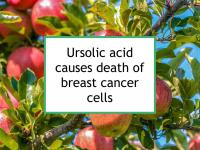Ursolic acid is a pentacyclic triterpene that forms the waxy coating of fruits such as apples and cranberries. It is also found in some herbs such as oregano. Ursolic acid has been shown to inhibit the growth of hormone receptor positive (ER+/PR+), HER2 overexpressing (HER2+) and triple negative (ER-/PR-/HER2-) breast cancer cells.
Now a new study has described for the first time a mechanism of action by which ursolic acid causes breast cancer cell death.
Food sources of ursolic acid
Apple peel is best common source of ursolic acid. However, conventionally grown apples typically are produced using relatively high levels of pesticides. The apples normally are washed after picking, which removes some of the pesticide residue, but also strips off some of the natural apple wax (i.e., the waxy cuticle, which contains the ursolic acid). Food grade wax is then applied to the apples, which can seal in some of the remaining pesticide residue. Therefore, organic apples are best.
Other foods that are also good sources of ursolic acid and have also been found to be chemopreventive with respect to breast cancer include basil, blueberries, cherries, cranberries, pomegranates, and plums (prunes in particular).
Latest research uncovers ursolic acid's mechanism of action
The study referenced at the beginning of this news story was designed to investigate the mechanism of action by which low dose ursolic acid exerts anti-breast cancer effects. To conduct the study, the authors first analyzed the effects of ursolic acid and betulinic acid (another pentacyclic triterpene) on various types of breast cancer cells (ER+/PR+/HER2-, triple negative, ER-/PR-/HER2+). Both triterpenes caused cell cycle arrest, DNA damage, and other precursors to apoptosis (programmed cell death). However, ursolic acid was found to produce a stronger and more extensive response than betulinic acid.
Ursolic acid activated the adenosine mono-phosphate-activated protein kinase (AMPK) pathway, causing both cytotoxic autophagy (a type of cell self-digestion) and apoptosis. This appeared to be the result of a combination of energy stress, elevation in nitric oxide levels, and ATM activation (which helps orchestrate DNA damage response). In addition, ursolic acid-induced apoptosis was associated with degradation of the cell nucleus and mitochondria. The authors conclude that ursolic acid at low micromolar levels may promote its anticancer action by targeting glycolysis (a type of cell energy production characteristic of cancer cells) in different types of breast cancer cells.
